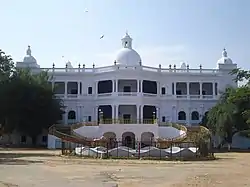Wanaparthy Samsthanam
Wanaparthy Samsthanam or Raja of Wanaparthy was a vassal of the Nizam of Hyderabad. He controlled the feudatory of Wanaparthy.[1][2] It was one of the three important samsthanams, the other two being Gadwal Samsthanam and Jatprole Samsthanam.

History
Wanaparthy Samsthanam traces its history back to the 14th century after the Kakatiya kingdom declined. The successive Turkic Muslim dynasties, who invaded and settled in Deccan, found it ideal for Samsthanam to prevail. It was surrounded by three other Samsthanams. The Wanaparthy Samsthanam was founded under the stewardship of Janumpally Veera Venkata Krishna Reddy . Suguru was the capital initially , and later Wanaparthy was made the capital of the Samsthanam in 1817.
The vassal family
Raja Rameshwar Rao II, who was a vassal of the Nizam of Hyderabad, died on 22 November 1922. As his successor, Krishna Dev, was a minor, his estate was managed as a Ward of the Court. Krishna Dev himself died before attaining majority and the crown passed on to his son Rameshwar Rao III, later to become simply J. Rameshwar Rao.
With the surname 'Janampalli', RaRao was the youngest son of the Raja of Wanaparthy. He had an older sister, Janamma, and elder brother Krishna Dev. The family roots have spread to the whole of Mahbubnagar district around Jadcherla and nearby talukas.
Raja Rameshwar Rao has said that he didn't have much interaction with his father – it was quite a formal relationship – and he only replied to him when spoken to.
The Kotwal of Hyderabad in late 19th and early 20 th centuries , Raja Bahadur Venkatarama Reddy was a grand nephew of the then Raja of Wanaparthy .
Contributions to architecture
Raja Rameshwar Rao left behind a grand legacy of structures constructed during his reign. 1885 constructed Wanaparthy Palace, Sarala Sagar Project is the second biggest dam in Asia with siphon technology. It is the oldest project in India after independence Raja of Wanaparthy Raja Rameshwara Rao founded by the Sarala Sagar Dam Project that has incorporated siphon technology from California, United States.[3][4]
Armed forces
The early Rajas maintained an army numbering 2000 infantry and 2000 cavalry. The time the kingdom fell into the ambit of the powerful Hyderabad State, until Wanaparthy's armed forces were absorbed into the Hyderabad Army as the Bison battalion on the orders of Nizam of Hyderabad. The ruler was relegated from commander to the honorary post of Inspector of the Bison battalion. Subsequent to the Hyderabad State’s merger with the Indian Union in 1948, all units of the Hyderabad State Forces were disbanded and volunteers absorbed into the Indian Army. These units, colloquially known as the "Hyderabadis" had, for that time, a unique mixed class composition.[5]
See also
- Gadwal Samsthanam
- Papannapet Samsthanam
- Samasthans of Hyderabad
References
- "I can speak good hyderabadi hindi: Aditi Rao Hydari". The Times of India. Retrieved 15 January 2019.
- "Archive News". The Hindu. Retrieved 15 January 2019.
- "A dam with unique Siphon Technology". Deccan Chronicle.
- "Sarala Sagar Project | An Engineering Wonder | with Auto Siphon System - YouTube". www.youtube.com. Retrieved 17 August 2020.
- "The Hindu : `Hyderabadis' celebrate Raising Day". The Hindu. Retrieved 15 January 2019.